Self-Assessed Experience of Emotional Involvement in Sensory Analysis Performed in Virtual Reality
Abstract
1. Introduction
1.1. Positive and Negative Affect Schedule (PANAS)
1.2. Impact of VR on Affective States
1.3. Effectiveness of VR in Eliciting Emotions
1.4. Positive and Negative Affect Schedule (PANAS) Questionnaire
1.5. Applications of Positive and Negative Affect Schedule (PANAS) in VR Sensory Analysis
2. Materials and Methods
2.1. Participants
2.2. Experimental Environment and Measurement Setup
2.3. Software Development and Virtual Sensory Booth
2.4. Procedure
2.5. Measures
Positive and Negative Affect Schedule (PANAS) Questionnaire
- The Positive Affect Score was calculated as follows: add the scores on PANAS items 1, 3, 5, 9, 10, 12, 14, 16, 17, and 19. Scores can range from 10–50, with higher scores representing higher levels of positive affect.
- The Negative Affect Score was calculated as follows: add the scores on PANAS items 2, 4, 6, 7, 8, 11, 13, 15, 18, and 20. Scores can range from 10–50, with lower scores representing lower levels of negative affect.
2.6. Data Analysis
3. Results and Discussion
3.1. Positive and Negative Affect Schedule (PANAS)
3.1.1. Overall Positive and Negative Affect Schedule (PANAS) Scores
3.1.2. Individual PANAS Items
3.1.3. Participants Positive and Negative Affect Schedule (PANAS) Score
3.2. Multiple Factor Analysis (MFA) on Positive and Negative Affect Schedule (PANAS)
3.3. Post-VR Questionnaire
4. Conclusions
Author Contributions
Funding
Institutional Review Board Statement
Informed Consent Statement
Data Availability Statement
Acknowledgments
Conflicts of Interest
References
- Gere, A.; Zulkarnain, A.H.B.; Szakál, D.; Fehér, O.; Kókai, Z. Virtual Reality Applications in Food Science. Current Knowledge and Prospects. Progress. Prog. Agric. Eng. Sci. 2021, 17, 3–14. [Google Scholar] [CrossRef]
- Han, D.-I.D.; Bergs, Y.; Moorhouse, N. Virtual Reality Consumer Experience Escapes: Preparing for the Metavese. Virtual Real. 2022, 26, 1443–1458. [Google Scholar] [CrossRef]
- Allcoat, D.; Von Mühlenen, A. Learning in Virtual Reality: Effects on Performance, Emotion and Engagement. Res. Learn. Technol. 2018, 26, 2140. [Google Scholar] [CrossRef]
- Díaz-García, A.; González-Robles, A.; Mor, S.; Mira, A.; Quero, S.; García-Palacios, A.; Baños, R.M.; Botella, C. Positive and Negative Affect Schedule (PANAS): Psychometric Properties of the Online Spanish Version in a Clinical Sample with Emotional Disorders. BMC Psychiatry 2020, 20, 56. [Google Scholar] [CrossRef] [PubMed]
- Datu, J.A.D.; Lee, A.S.Y.; Fung, W.K.; Cheung, R.Y.M.; Chung, K.K.H. Prospering in the Midst of the COVID-19 Pandemic: The Effects of PROSPER-Based Intervention on Psychological Outcomes among Preschool Teachers. J. Sch. Psychol. 2022, 94, 66–82. [Google Scholar] [CrossRef] [PubMed]
- Wang, Y.; Zheng, Z.; Wang, X.; Li, Y. Unraveling the Effect of Ambivalence over Emotional Expression on Subjective Wellbeing in Chinese College Students in Romantic Relationships: A Multiple Mediation Model. Front. Psychiatry 2022, 13, 982406. [Google Scholar] [CrossRef] [PubMed]
- Callejo, M.J. Present Situation on the Descriptive Sensory Analysis of Bread: On the Descriptive Sensory Analysis of Bread. J. Sens. Stud. 2011, 26, 255–268. [Google Scholar] [CrossRef]
- Yang, J.; Lee, J. Application of Sensory Descriptive Analysis and Consumer Studies to Investigate Traditional and Authentic Foods: A Review. Foods 2019, 8, 54. [Google Scholar] [CrossRef]
- Szakál, D.; Cao, X.; Fehér, O.; Gere, A. How Do Ethnically Congruent Music and Meal Drive Food Choices? Curr. Res. Food Sci. 2023, 6, 100508. [Google Scholar] [CrossRef]
- Gulzar, N.; Sameen, A.; Muhammad Aadil, R.; Sahar, A.; Rafiq, S.; Huma, N.; Nadeem, M.; Arshad, R.; Muqadas Saleem, I. Descriptive Sensory Analysis of Pizza Cheese Made from Mozzarella and Semi-Ripened Cheddar Cheese Under Microwave and Conventional Cooking. Foods 2020, 9, 214. [Google Scholar] [CrossRef]
- Ickes, C.M.; Cadwallader, K.R. Characterization of Sensory Differences in Mixing and Premium Rums Through the Use of Descriptive Sensory Analysis. J. Food Sci. 2017, 82, 2679–2689. [Google Scholar] [CrossRef] [PubMed]
- Lubinska-Szczygeł, M.; Polkowska, Ż.; Dymerski, T.; Gorinstein, S. Comparison of the Physical and Sensory Properties of Hybrid Citrus Fruit Jaffa® Sweetie in Relation to the Parent Fruits. Molecules 2020, 25, 2748. [Google Scholar] [CrossRef] [PubMed]
- Vilela, A.; Bacelar, E.; Pinto, T.; Anjos, R.; Correia, E.; Gonçalves, B.; Cosme, F. Beverage and Food Fragrance Biotechnology, Novel Applications, Sensory and Sensor Techniques: An Overview. Foods 2019, 8, 643. [Google Scholar] [CrossRef]
- Torres, E.N.L.; Mateus, S.; Attalya, F.; Claudinei, E.B.J. A Systematic Review of Cultural Adaptations of the Positive Affect and Negative Affect Schedule (PANAS). PsyArXiv 2023. [Google Scholar] [CrossRef]
- Grèzes, J.; Erblang, M.; Vilarem, E.; Quiquempoix, M.; Van Beers, P.; Guillard, M.; Sauvet, F.; Mennella, R.; Rabat, A. Impact of Total Sleep Deprivation and Related Mood Changes on Approach-Avoidance Decisions to Threat-Related Facial Displays. Sleep 2021, 44, zsab186. [Google Scholar] [CrossRef] [PubMed]
- Flores-Kanter, P.E.; Moretti, L.; Medrano, L.A. A Narrative Review of Emotion Regulation Process in Stress and Recovery Phases. Heliyon 2021, 7, e07218. [Google Scholar] [CrossRef]
- Humboldt, S.V.; Monteiro, A.; Leal, I. Validation of the PANAS: A Measure of Positive and Negative Affect for Use with Cross-National Older Adults. Rev. Eur. Stud. 2017, 9, 10. [Google Scholar] [CrossRef]
- Hong, S.; Joung, D.; Lee, J.; Kim, D.-Y.; Kim, S.; Park, B.-J. The Effects of Watching a Virtual Reality (VR) Forest Video on Stress Reduction in Adults. J. People Plants Environ. 2019, 22, 309–319. [Google Scholar] [CrossRef]
- Tarrant, J. The Impact of Virtual Reality on Mood States Prior to Blood Donation. SJPBS 2019, 2, 254–256. [Google Scholar] [CrossRef]
- Yeo, N.L.; White, M.P.; Alcock, I.; Garside, R.; Dean, S.G.; Smalley, A.J.; Gatersleben, B. What Is the Best Way of Delivering Virtual Nature for Improving Mood? An Experimental Comparison of High Definition TV, 360° Video, and Computer Generated Virtual Reality. J. Environ. Psychol. 2020, 72, 101500. [Google Scholar] [CrossRef]
- Pavic, K.; Vergilino-Perez, D.; Gricourt, T.; Chaby, L. Because I’m Happy—An Overview on Fostering Positive Emotions Through Virtual Reality. Front. Virtual Real. 2022, 3, 788820. [Google Scholar] [CrossRef]
- Ślósarz, L.; Jurczyk-Romanowska, E.; Rosińczuk, J.; Kazimierska-Zając, M. Virtual Reality as a Teaching Resource Which Reinforces Emotions in the Teaching Process. SAGE Open 2022, 12, 215824402211180. [Google Scholar] [CrossRef]
- D’Cunha, N.M.; Nguyen, D.; Naumovski, N.; McKune, A.J.; Kellett, J.; Georgousopoulou, E.N.; Frost, J.; Isbel, S. A Mini-Review of Virtual Reality-Based Interventions to Promote Well-Being for People Living with Dementia and Mild Cognitive Impairment. Gerontology 2019, 65, 430–440. [Google Scholar] [CrossRef] [PubMed]
- Faric, N.; Potts, H.W.W.; Hon, A.; Smith, L.; Newby, K.; Steptoe, A.; Fisher, A. What Players of Virtual Reality Exercise Games Want: Thematic Analysis of Web-Based Reviews. J. Med. Internet Res. 2019, 21, e13833. [Google Scholar] [CrossRef] [PubMed]
- Ochi, G.; Kuwamizu, R.; Fujimoto, T.; Ikarashi, K.; Yamashiro, K.; Sato, D. The Effects of Acute Virtual Reality Exergaming on Mood and Executive Function: Exploratory Crossover Trial. JMIR Serious Games 2022, 10, e38200. [Google Scholar] [CrossRef] [PubMed]
- Chen, B.; Wang, Y.; Wang, L. The Effects of Virtual Reality-Assisted Language Learning: A Meta-Analysis. Sustainability 2022, 14, 3147. [Google Scholar] [CrossRef]
- Frentzel-Beyme, L.; Krämer, N.C. Historical Time Machines: Experimentally Investigating Potentials and Impacts of Immersion in Historical VR on History Education and Morality. Technol. Mind Behav. 2023, 4. [Google Scholar] [CrossRef]
- Jin, B.; Kim, G.; Moore, M.; Rothenberg, L. Consumer Store Experience through Virtual Reality: Its Effect on Emotional States and Perceived Store Attractiveness. Fash. Text. 2021, 8, 19. [Google Scholar] [CrossRef]
- Zhang, Y.; Song, Y. The Effects of Sensory Cues on Immersive Experiences for Fostering Technology-Assisted Sustainable Behavior: A Systematic Review. Behav. Sci. 2022, 12, 361. [Google Scholar] [CrossRef]
- Schöne, B.; Kisker, J.; Lange, L.; Gruber, T.; Sylvester, S.; Osinsky, R. The Reality of Virtual Reality. Front. Psychol. 2023, 14, 1093014. [Google Scholar] [CrossRef]
- Liu, Q.; Wang, Y.; Tang, Q.; Liu, Z. Do You Feel the Same as I Do? Differences in Virtual Reality Technology Experience and Acceptance Between Elderly Adults and College Students. Front. Psychol. 2020, 11, 573673. [Google Scholar] [CrossRef] [PubMed]
- Marín-Morales, J.; Higuera-Trujillo, J.L.; Greco, A.; Guixeres, J.; Llinares, C.; Scilingo, E.P.; Alcañiz, M.; Valenza, G. Affective Computing in Virtual Reality: Emotion Recognition from Brain and Heartbeat Dynamics Using Wearable Sensors. Sci. Rep. 2018, 8, 13657. [Google Scholar] [CrossRef] [PubMed]
- Marín-Morales, J.; Llinares, C.; Guixeres, J.; Alcañiz, M. Emotion Recognition in Immersive Virtual Reality: From Statistics to Affective Computing. Sensors 2020, 20, 5163. [Google Scholar] [CrossRef] [PubMed]
- Sukotjo, C.; Schreiber, S.; Li, J.; Zhang, M.; Chia-Chun Yuan, J.; Santoso, M. Development and Student Perception of Virtual Reality for Implant Surgery. Educ. Sci. 2021, 11, 176. [Google Scholar] [CrossRef]
- Torrico, D.D.; Han, Y.; Sharma, C.; Fuentes, S.; Gonzalez Viejo, C.; Dunshea, F.R. Effects of Context and Virtual Reality Environments on the Wine Tasting Experience, Acceptability, and Emotional Responses of Consumers. Foods 2020, 9, 191. [Google Scholar] [CrossRef]
- Watson, D.; Clark, L.A.; Tellegen, A. Development and Validation of Brief Measures of Positive and Negative Affect: The PANAS Scales. J. Personal. Soc. Psychol. 1988, 54, 1063–1070. [Google Scholar] [CrossRef]
- Kong, Y.; Sharma, C.; Kanala, M.; Thakur, M.; Li, L.; Xu, D.; Harrison, R.; Torrico, D.D. Virtual Reality and Immersive Environments on Sensory Perception of Chocolate Products: A Preliminary Study. Foods 2020, 9, 515. [Google Scholar] [CrossRef]
- Crofton, E.; Murray, N.; Botinestean, C. Exploring the Effects of Immersive Virtual Reality Environments on Sensory Perception of Beef Steaks and Chocolate. Foods 2021, 10, 1154. [Google Scholar] [CrossRef]
- Zulkarnain, A.H.B.; Kókai, Z.; Gere, A. Validation of a Virtual Sensory Laboratory for Consumer Sensory Evaluation. SSRN 2023. [Google Scholar] [CrossRef]
- Mielmann, A.; Brunner, T.A. Linking the Sensory Taste Properties of Chocolate-Based Biscuits to Consumers’ Emotions: A Cross-Cultural Study. Appl. Sci. 2022, 12, 8038. [Google Scholar] [CrossRef]
- Pramudya, R.C.; Seo, H.-S. Influences of Product Temperature on Emotional Responses to, and Sensory Attributes of, Coffee and Green Tea Beverages. Front. Psychol. 2018, 8, 2264. [Google Scholar] [CrossRef] [PubMed]
- Satpute, A.B.; Kang, J.; Bickart, K.C.; Yardley, H.; Wager, T.D.; Barrett, L.F. Involvement of Sensory Regions in Affective Experience: A Meta-Analysis. Front. Psychol. 2015, 6, 1860. [Google Scholar] [CrossRef]
- ISO 8589: 2007; Sensory Analysis. ISO: Geneva, Switzerland, 2007.
- Browning, M.H.E.M.; Mimnaugh, K.J.; Van Riper, C.J.; Laurent, H.K.; LaValle, S.M. Can Simulated Nature Support Mental Health? Comparing Short, Single-Doses of 360-Degree Nature Videos in Virtual Reality with the Outdoors. Front. Psychol. 2020, 10, 2667. [Google Scholar] [CrossRef]
- Pavic, K.; Chaby, L.; Gricourt, T.; Vergilino-Perez, D. Feeling Virtually Present Makes Me Happier: The Influence of Immersion, Sense of Presence, and Video Contents on Positive Emotion Induction. Cyberpsychology Behav. Soc. Netw. 2023, 26, 238–245. [Google Scholar] [CrossRef] [PubMed]
- Basbasse, Y.E.; Packheiser, J.; Peterburs, J.; Maymon, C.; Güntürkün, O.; Grimshaw, G.; Ocklenburg, S. Walk the Plank! Using Mobile EEG to Investigate Emotional Lateralization of Immersive Fear in Virtual Reality. bioRxiv 2022. [Google Scholar] [CrossRef]
- Lavoie, R.; Main, K.; King, C.; King, D. Virtual Experience, Real Consequences: The Potential Negative Emotional Consequences of Virtual Reality Gameplay. Virtual Real. 2021, 25, 69–81. [Google Scholar] [CrossRef]
- Li, H.; Dong, W.; Wang, Z.; Chen, N.; Wu, J.; Wang, G.; Jiang, T. Effect of a Virtual Reality-Based Restorative Environment on the Emotional and Cognitive Recovery of Individuals with Mild-to-Moderate Anxiety and Depression. IJERPH 2021, 18, 9053. [Google Scholar] [CrossRef] [PubMed]
- Wang, X.; Zhang, S.; Zhang, X. How Do Word Valence and Classes Influence Lexical Processing? Evidence from Virtual Reality Emotional Contexts. Front. Psychol. 2023, 13, 1032384. [Google Scholar] [CrossRef]
- Mahmud, A.A.; Zakaria, H.; Mohd Yusoff, M.Z.; Nik Jaafar, N.R.; Baharudin, A.; Tamil, A.M. Brief Virtual Reality Exposure Therapy and Its Effects on Negative and Positive Emotions Among Healthy Working Adults: A Feasibility Study. Alpha Psychiatry 2022, 23, 223–229. [Google Scholar] [CrossRef]
- Martingano, A.J.; Hererra, F.; Konrath, S. Virtual Reality Improves Emotional but Not Cognitive Empathy: A Meta-Analysis. Technol. Mind Behav. 2021, 2. [Google Scholar] [CrossRef]
- Gomez, J.; Hoffman, H.G.; Bistricky, S.L.; Gonzalez, M.; Rosenberg, L.; Sampaio, M.; Garcia-Palacios, A.; Navarro-Haro, M.V.; Alhalabi, W.; Rosenberg, M.; et al. The Use of Virtual Reality Facilitates Dialectical Behavior Therapy® “Observing Sounds and Visuals” Mindfulness Skills Training Exercises for a Latino Patient with Severe Burns: A Case Study. Front. Psychol. 2017, 8, 1611. [Google Scholar] [CrossRef] [PubMed]
- Chirico, A.; Yaden, D.B.; Riva, G.; Gaggioli, A. The Potential of Virtual Reality for the Investigation of Awe. Front. Psychol. 2016, 7, 1766. [Google Scholar] [CrossRef] [PubMed]
- Pallavicini, F.; Pepe, A. Virtual Reality Games and the Role of Body Involvement in Enhancing Positive Emotions and Decreasing Anxiety: Within-Subjects Pilot Study. JMIR Serious Games 2020, 8, e15635. [Google Scholar] [CrossRef] [PubMed]
- Lemmens, J.S.; Simon, M.; Sumter, S.R. Fear and Loathing in VR: The Emotional and Physiological Effects of Immersive Games. Virtual Real. 2022, 26, 223–234. [Google Scholar] [CrossRef]
- Stallmann, L.; Tran, M.; Rudrauf, D.; Dukes, D.; Samson, A.C. Simulating Social Emotion Regulation in Virtual Reality: Effect of Virtual Social Support Following Ostracism in a Cyberball Game. Int. J. Emerg. Technol. Learn. 2023, 18, 4–27. [Google Scholar] [CrossRef]
- Diemer, J.; Alpers, G.W.; Peperkorn, H.M.; Shiban, Y.; Mühlberger, A. The Impact of Perception and Presence on Emotional Reactions: A Review of Research in Virtual Reality. Front. Psychol. 2015, 6, 26. [Google Scholar] [CrossRef]
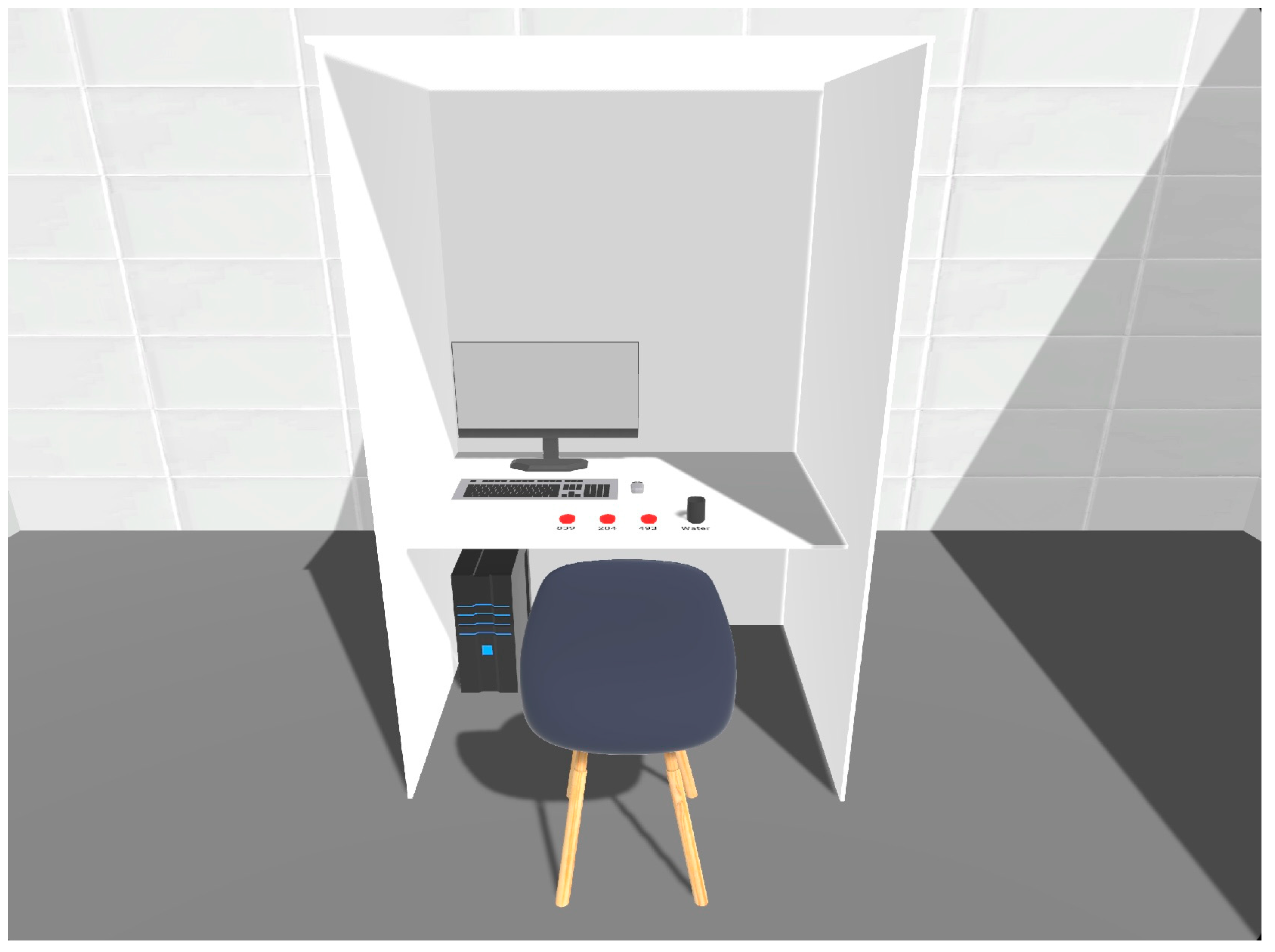


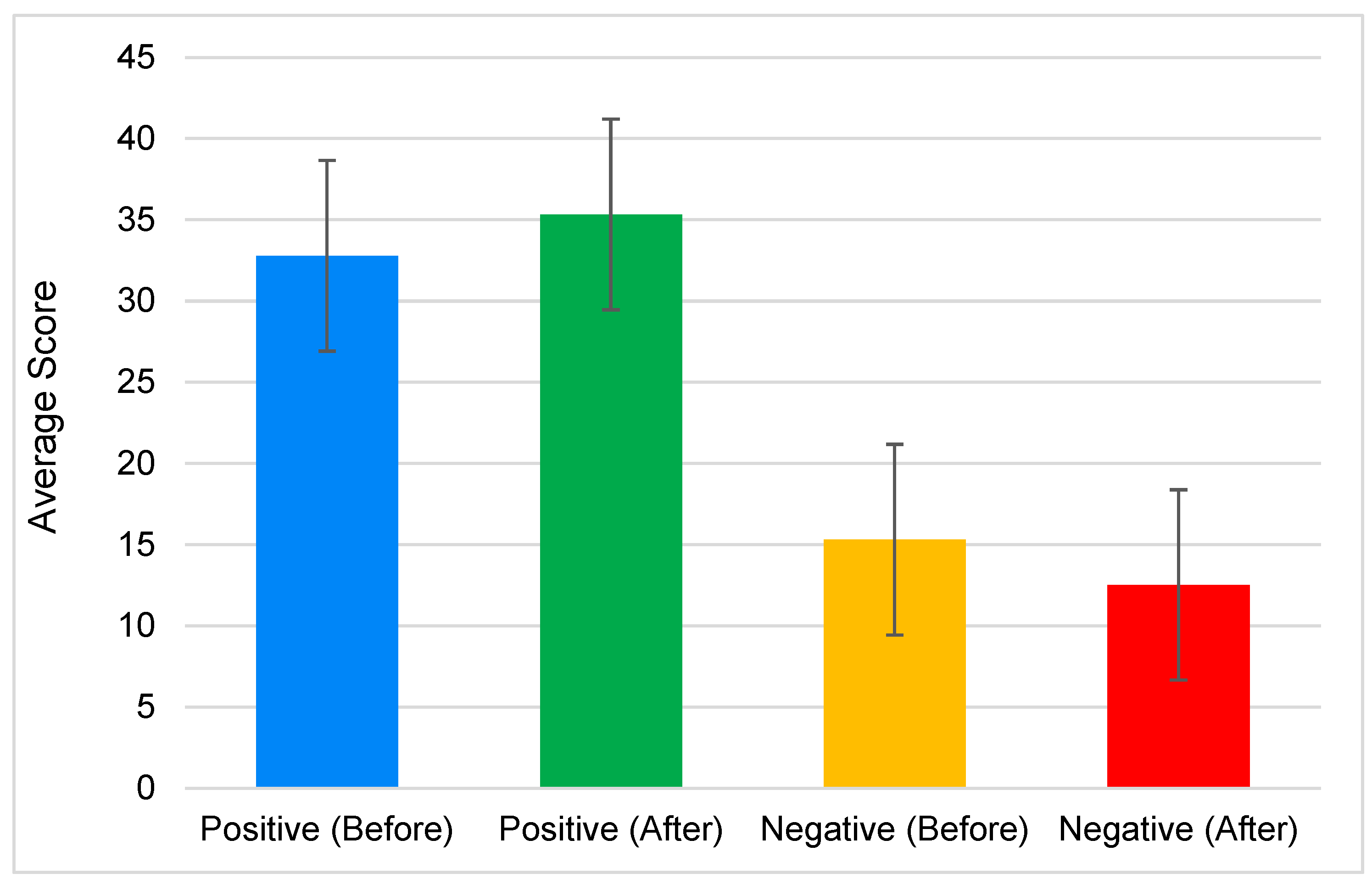

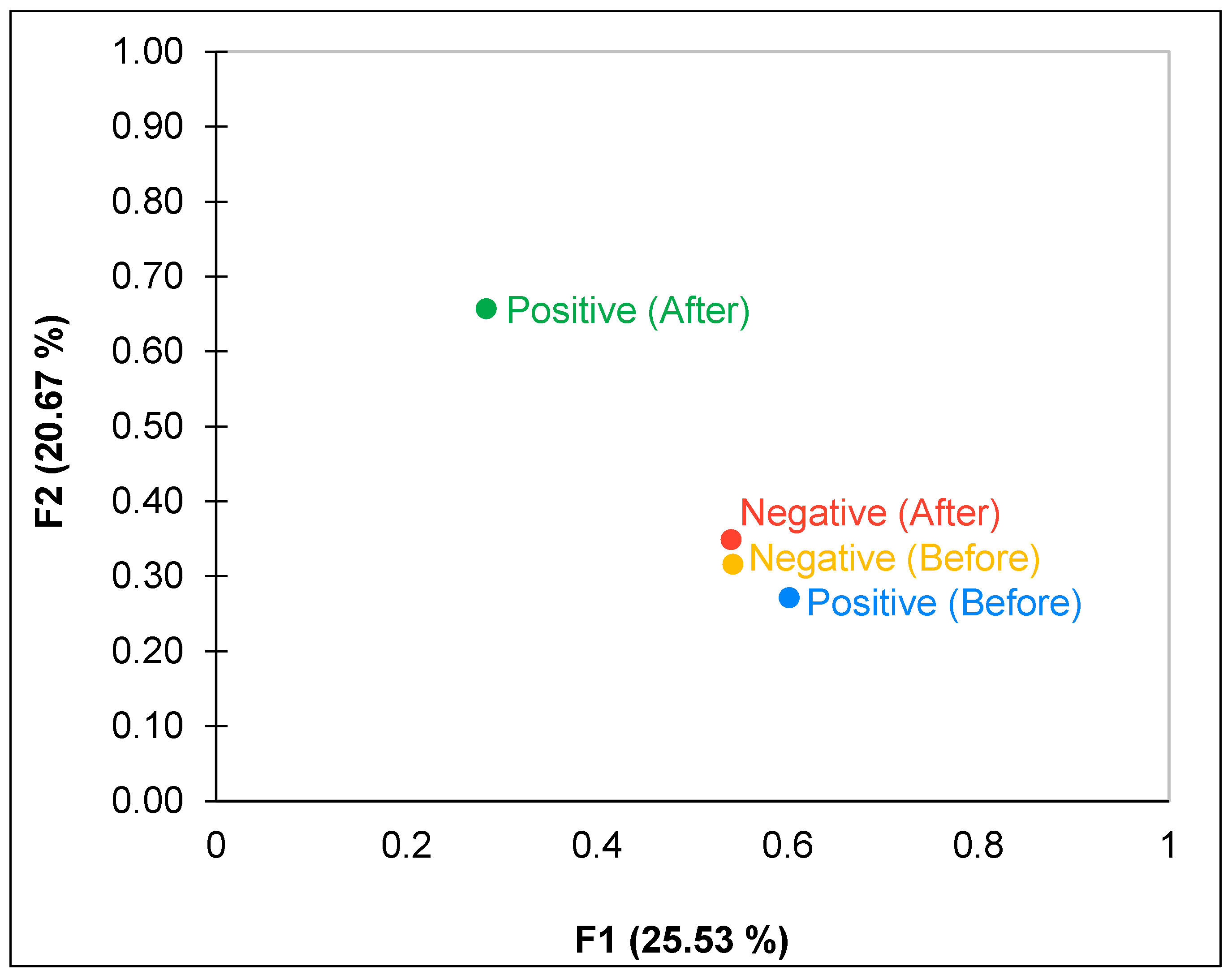
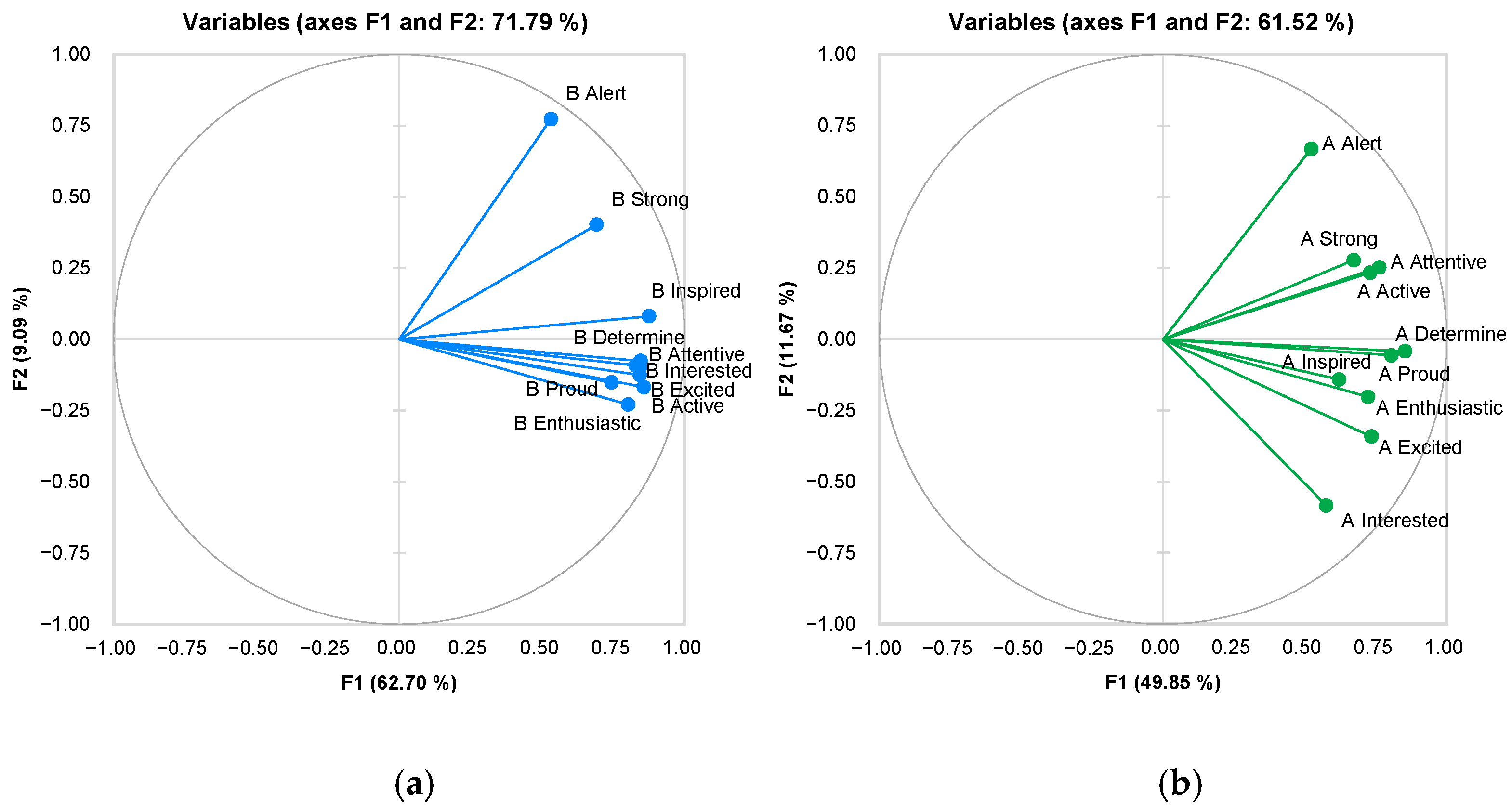
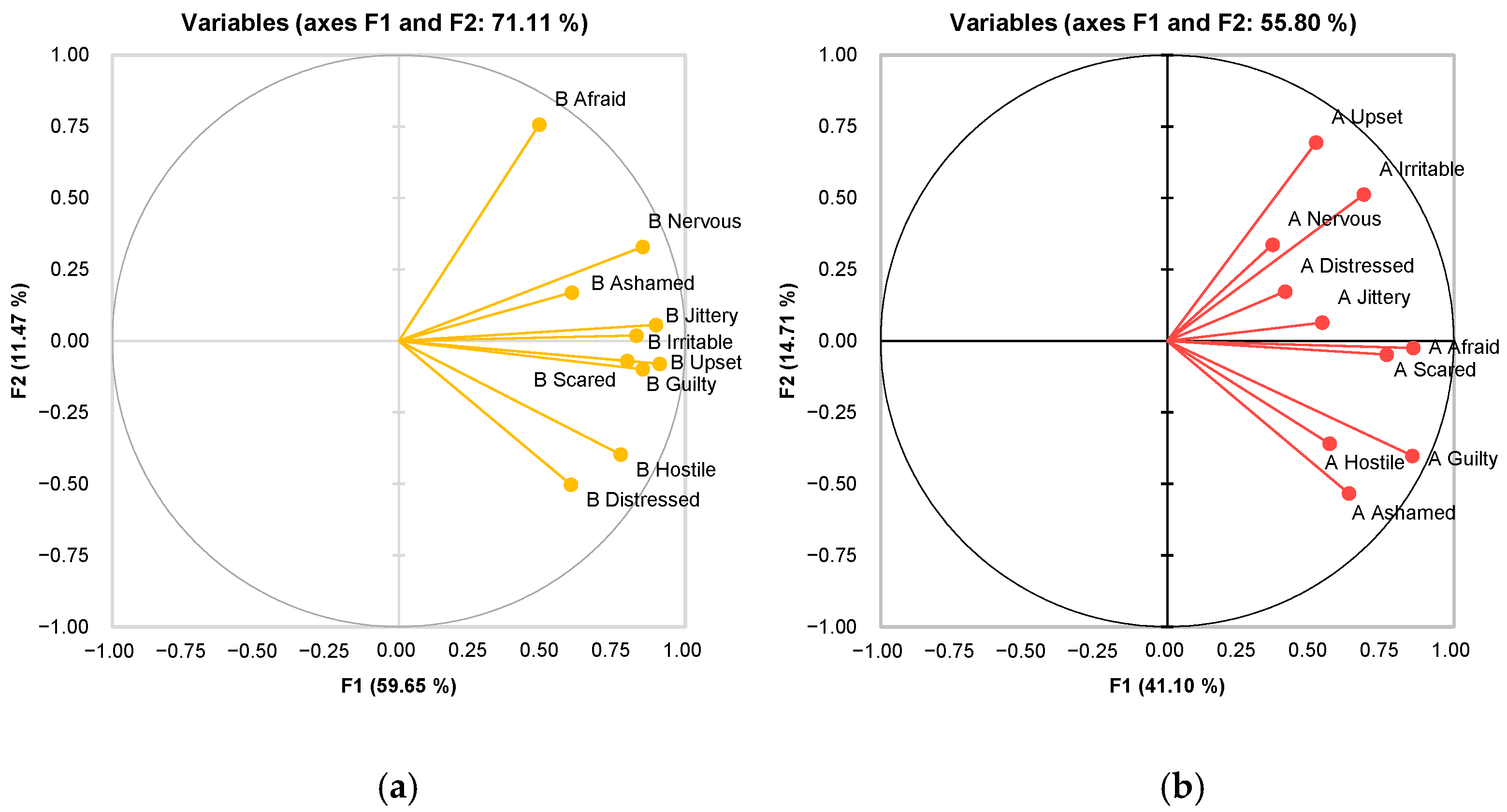
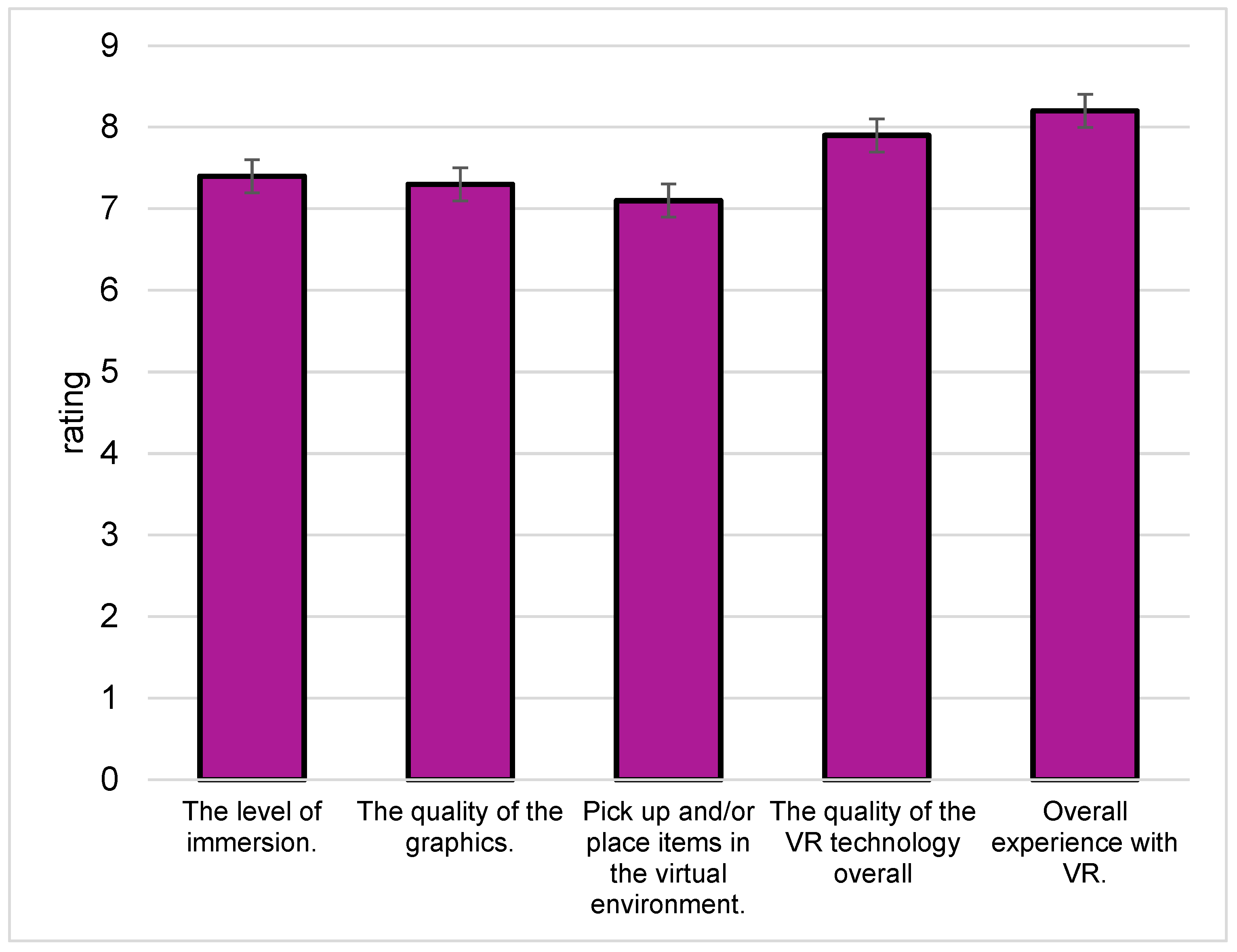
| Gender | Number of Participants (n) | Percentage (%) | Age | VR Experience | |||
|---|---|---|---|---|---|---|---|
| Mean ± SD | Min | Max | Yes | No | |||
| Male | 16 | 38 | 25.19 ± 3.10 | 21 | 33 | 5 | 11 |
| Female | 26 | 62 | 25.50 ± 2.97 | 21 | 32 | 10 | 16 |
| Total | 42 | 100 | 25.31 ± 2.98 | 21 | 33 | 15 | 27 |
| Emotions | Very Slightly or Not at All | A Little | Moderately | Quite a Bit | Extremely | |
|---|---|---|---|---|---|---|
| PANAS 1 | Interested | ◻ | ◻ | ◻ | ◻ | ◻ |
| PANAS 2 | Distressed | ◻ | ◻ | ◻ | ◻ | ◻ |
| PANAS 3 | Excited | ◻ | ◻ | ◻ | ◻ | ◻ |
| PANAS 4 | Upset | ◻ | ◻ | ◻ | ◻ | ◻ |
| PANAS 5 | Strong | ◻ | ◻ | ◻ | ◻ | ◻ |
| PANAS 6 | Guilty | ◻ | ◻ | ◻ | ◻ | ◻ |
| PANAS 7 | Scared | ◻ | ◻ | ◻ | ◻ | ◻ |
| PANAS 8 | Hostile | ◻ | ◻ | ◻ | ◻ | ◻ |
| PANAS 9 | Enthusiastic | ◻ | ◻ | ◻ | ◻ | ◻ |
| PANAS 10 | Proud | ◻ | ◻ | ◻ | ◻ | ◻ |
| PANAS 11 | Irritable | ◻ | ◻ | ◻ | ◻ | ◻ |
| PANAS 12 | Alert | ◻ | ◻ | ◻ | ◻ | ◻ |
| PANAS 13 | Ashamed | ◻ | ◻ | ◻ | ◻ | ◻ |
| PANAS 14 | Inspired | ◻ | ◻ | ◻ | ◻ | ◻ |
| PANAS 15 | Nervous | ◻ | ◻ | ◻ | ◻ | ◻ |
| PANAS 16 | Determine | ◻ | ◻ | ◻ | ◻ | ◻ |
| PANAS 17 | Attentive | ◻ | ◻ | ◻ | ◻ | ◻ |
| PANAS 18 | Jittery | ◻ | ◻ | ◻ | ◻ | ◻ |
| PANAS 19 | Active | ◻ | ◻ | ◻ | ◻ | ◻ |
| PANAS 20 | Afraid | ◻ | ◻ | ◻ | ◻ | ◻ |
| Emotions | Before | After | p-Value | Emotion Increased (↑) or Decreased (↓) | |
|---|---|---|---|---|---|
| Mean ± SD | Mean ± SD | ||||
| Positive | Interested | 3.95 ± 1.13 | 4.45 ± 0.67 | 0.008 | ↑ |
| Excited | 3.50 ± 1.27 | 4.00 ± 1.13 | 0.030 | ↑ | |
| Strong | 3.21 ± 1.35 | 3.33 ± 1.44 | 0.349 | ||
| Enthusiastic | 3.38 ± 1.19 | 3.64 ± 1.27 | 0.166 | ||
| Proud | 2.93 ± 1.47 | 3.67 ± 1.43 | 0.011 | ↑ | |
| Alert | 2.64 ± 1.39 | 2.21 ± 1.57 | 0.095 | ||
| Inspired | 3.33 ± 1.26 | 4.00 ± 1.10 | 0.006 | ↑ | |
| Determine | 3.07 ± 1.30 | 3.17 ± 1.50 | 0.378 | ||
| Attentive | 3.21 ± 1.42 | 3.07 ± 1.63 | 0.335 | ||
| Active | 3.55 ± 1.23 | 3.79 ± 1.12 | 0.178 | ||
| Negative | Distressed | 1.88 ± 1.15 | 1.74 ± 1.21 | 0.291 | |
| Upset | 1.48 ± 1.09 | 1.24 ± 0.79 | 0.127 | ||
| Guilty | 1.48 ± 0.99 | 1.10 ± 0.43 | 0.013 | ↓ | |
| Scared | 1.29 ± 0.77 | 1.14 ± 0.52 | 0.162 | ||
| Hostile | 1.50 ± 0.99 | 1.33 ± 0.72 | 0.191 | ||
| Irritable | 1.62 ± 1.13 | 1.33 ± 0.90 | 0.101 | ||
| Ashamed | 1.29 ± 0.64 | 1.10 ± 0.37 | 0.049 | ↓ | |
| Nervous | 1.95 ± 1.19 | 1.17 ± 0.44 | <0.001 | ↓ | |
| Jittery | 1.67 ± 1.00 | 1.36 ± 0.82 | 0.063 | ||
| Afraid | 1.17 ± 0.38 | 1.02 ± 0.15 | 0.013 | ↓ | |
Disclaimer/Publisher’s Note: The statements, opinions and data contained in all publications are solely those of the individual author(s) and contributor(s) and not of MDPI and/or the editor(s). MDPI and/or the editor(s) disclaim responsibility for any injury to people or property resulting from any ideas, methods, instructions or products referred to in the content. |
© 2024 by the authors. Licensee MDPI, Basel, Switzerland. This article is an open access article distributed under the terms and conditions of the Creative Commons Attribution (CC BY) license (https://creativecommons.org/licenses/by/4.0/).
Share and Cite
Zulkarnain, A.H.B.; Cao, X.; Kókai, Z.; Gere, A. Self-Assessed Experience of Emotional Involvement in Sensory Analysis Performed in Virtual Reality. Foods 2024, 13, 375. https://doi.org/10.3390/foods13030375
Zulkarnain AHB, Cao X, Kókai Z, Gere A. Self-Assessed Experience of Emotional Involvement in Sensory Analysis Performed in Virtual Reality. Foods. 2024; 13(3):375. https://doi.org/10.3390/foods13030375
Chicago/Turabian StyleZulkarnain, Abdul Hannan Bin, Xu Cao, Zoltán Kókai, and Attila Gere. 2024. "Self-Assessed Experience of Emotional Involvement in Sensory Analysis Performed in Virtual Reality" Foods 13, no. 3: 375. https://doi.org/10.3390/foods13030375
APA StyleZulkarnain, A. H. B., Cao, X., Kókai, Z., & Gere, A. (2024). Self-Assessed Experience of Emotional Involvement in Sensory Analysis Performed in Virtual Reality. Foods, 13(3), 375. https://doi.org/10.3390/foods13030375







